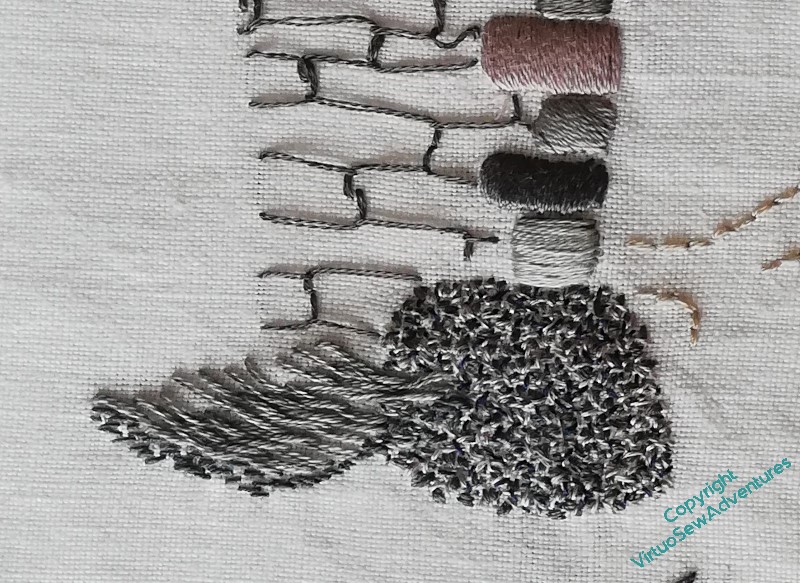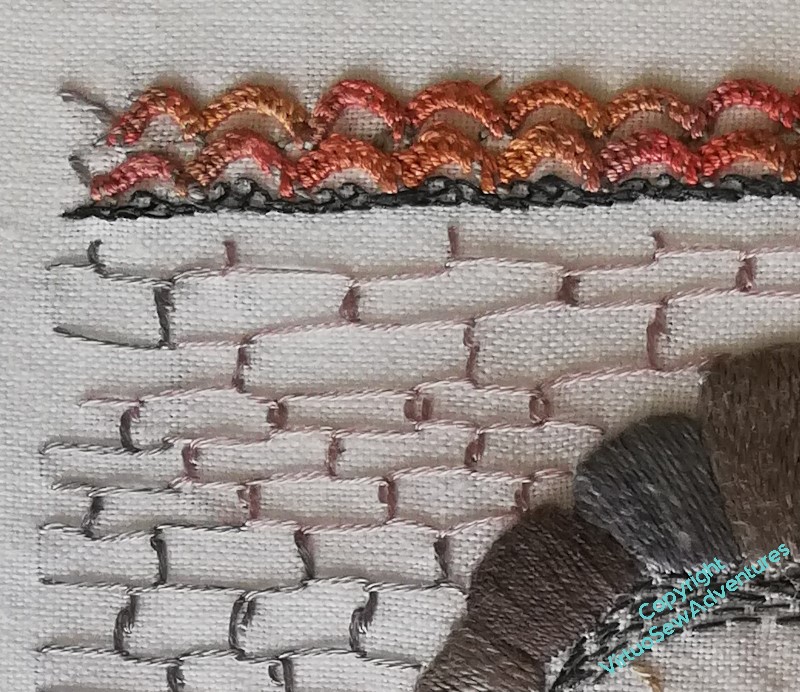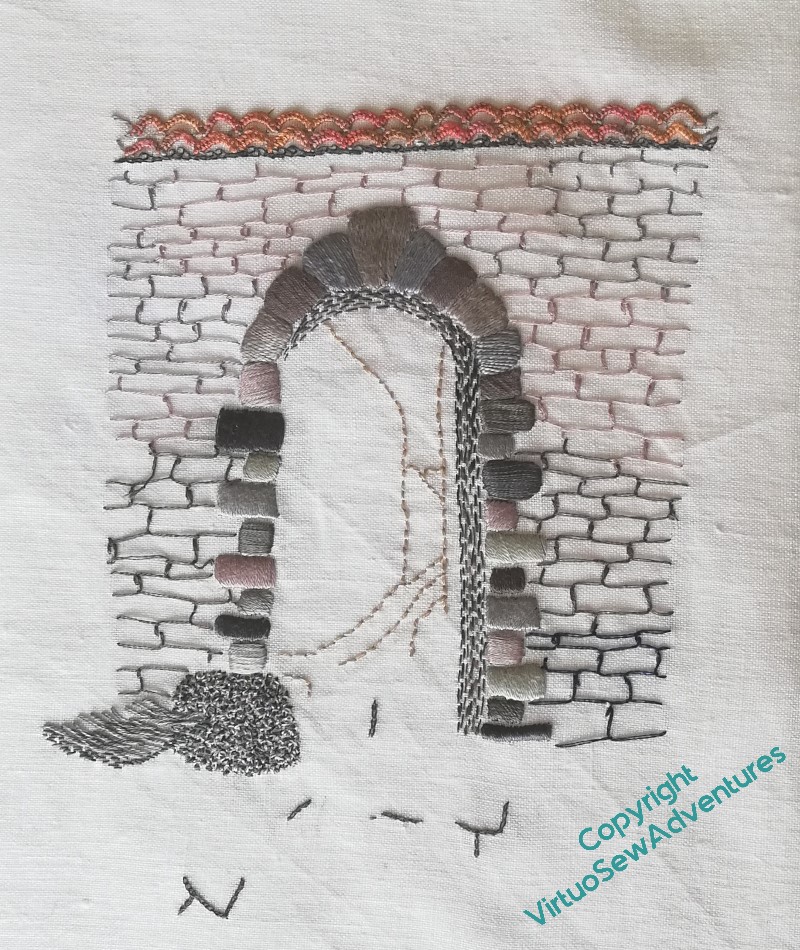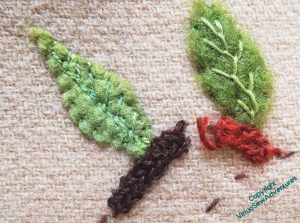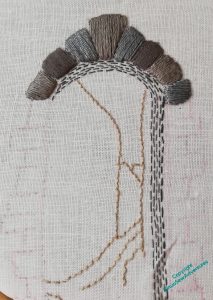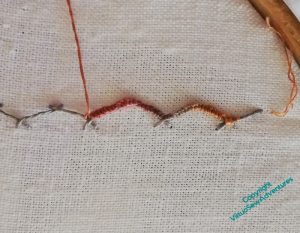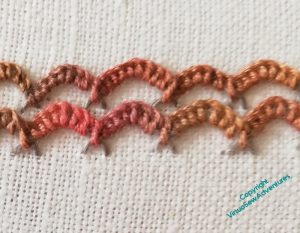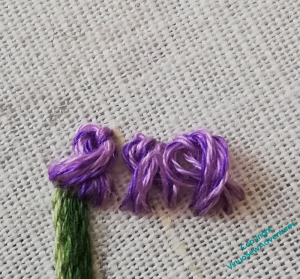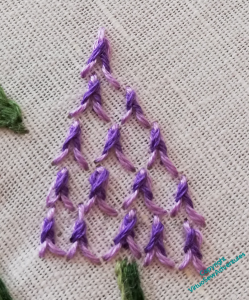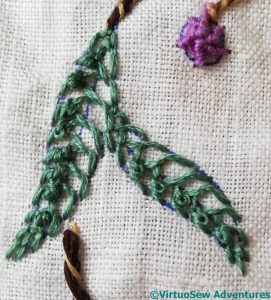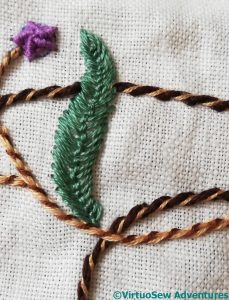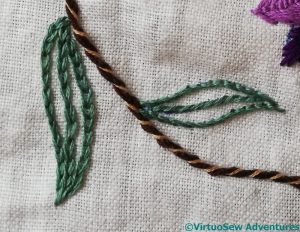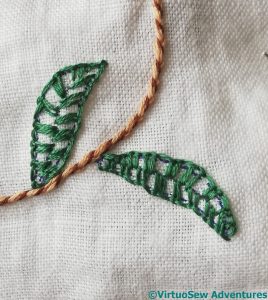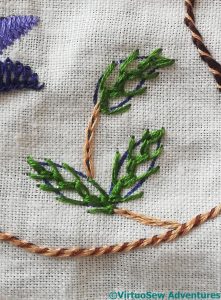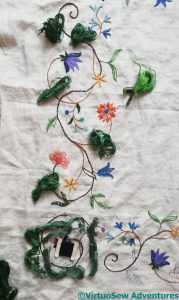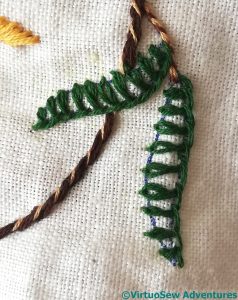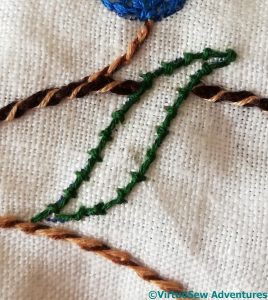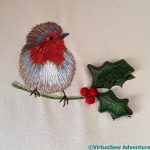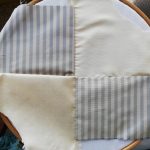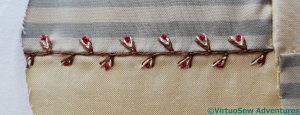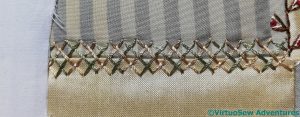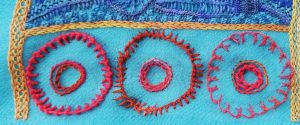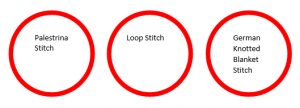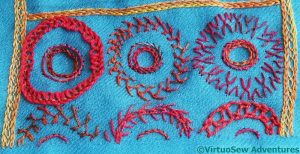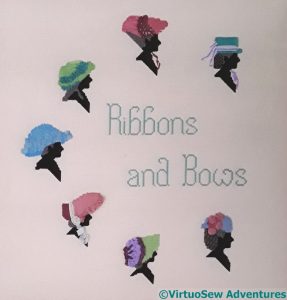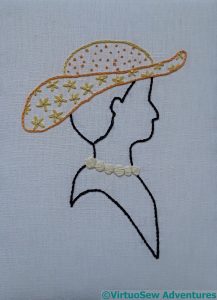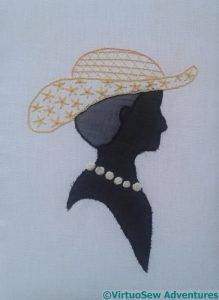Tag: stitches
Watermill Stitchery – Finishing Stones of Verrucola
You may recall that I was planning to use this design as a way to explore stonework in various forms, and to demonstrate stitches that might be chosen in each case.
So here we have padded satin stitch for the cut and dressed stone of the arch, and seed stitch for the boulder beside it. The seat and the blocks of the wall around the arch are both in Cretan Stitch, the one spaced out and turned into a filling stitch of sorts, and the other compressed and set at a slight angle to represent the slightly dished stone seat.
This view shows the height of the padding on the keystone and the line of dark stitching under the tiles, which is a line of chain stitch feathered on one side only to get one crisp edge and one which suggests the darkness of the arch. You can also see from the shadows just how strongly raised the blanket stitched herringbone stitch appears.
The Cretan Stitch rows are carefully varied in length and depth to show how the rows of cut stone are not all the same height or length. This was a stitch much more easily worked in a hoop, where you can see the layout, than in the hand – even though I prefer working in the hand where I can.
And here is the finished “Stones of Verrucola”.
There are some elements which work much better than others. The outlines through the arch and the chain stitch edges of the flagstones may not be necessary, and the shadow under the seat is a little too small.
The seed stitches could have been bigger, maybe even grouped, and maybe emphasizing one of the lighter colours more, but I am very happy that all of the different textures are truly differentiated.
Besides, all that I am seeking to do is to demonstrate ideas that the students can take on or not as they choose. If at the end of the week I have a classful of mini-mes, I will have failed. What I want is a group who’ve tried, experimented, and each of them produced, maybe even only a fragment, but still something that makes me think, “Goodness, I wish I’d thought of that!”
More progress on the Little Jacket
I decided that I was going to work all the major stems in one of the Braid Stitches, so I spent quite a bit of time revisiting Plaited Braid Stitch, the ordinary Braid Stitch, and others. For a while that was a little painful.
First of all, I was reminded that these stitches don’t stay in your hands the way (say) Feather Stitch does, and then secondly I was reminded that they are very thread-hungry. It’s (almost) all on the front, where you get the benefit of it, but metres get swallowed up in short order. And I knew there would be metres of whatever-stitch-I-chose. My stash doesn’t run to that sort of length, but having performed a few experiments, I realised that sock yarn would be perfectly useable, given the fabric I’m working on.
I finally chose to work Holly Braid Stitch, which I experimented with in 2014 when I was working on the Glittering Nightcap. I’d found it in Jacqui Carey’s book “Elizabethan Stitches”, and after some struggles it had worked pretty well. This time I tied myself in so many knots with it that I asked for help in the Historic Hand Embroidery group on fb, only to find that very few people had attempted it. However, those who did were very helpful, and several very intrigued people asked me could I video it if I got it to work…
So I have. What you see here is probably not enough to learn the stitch from without also following Jacqui’s diagrams and instructions, but I think it helps with the “workflow” of the stitch, which is not well represented in those diagrams, I suspect purely because, as a braidmaker, she thinks differently about the way a stitch works.
Once I had the stitch down pat, I bought a rather gorgeous sock yarn (Woodland Fire from The Yarn Gallery), and whenever I wasn’t sure about the details I wanted to add to a flower or leaf, I just kept on with the stems..
And on. And on!
And now, Episode 72 of Slow TV Stitchery is now live, in which we encounter difficulties in working a pattern backwards, experiment with French Knots, and recall “Leaving the Tyne”.
Watermill Stitchery – Stones of Verrucola
I’m continuing to explore ideas for the course at The Watermill in Posara, and this one is inspired by the first outing of the painting course I went on. Verrucola is a medieval village and fortress not far from Fivizzano, with a deep stream valley, some very impressive buildings – and a delightful trattoria just inside the walls.
I want to explore the different ways an embroiderer might choose to explore the textures of stone that a site like this afford – the living rock of the hillside, cut stone used for building, and the shaped and smoothed stone used for architectural features.
You can see in the first picture that I have just “drawn in” the street beyond the gate with back stitch and used darning stitch to suggest the shadow beneath the arch.
I’m using padded satin stitch for the cut and smoothed stone of the arch, but since I find that an exasperating stitch, I’ve alternated working on the arch with the tiles which cap the wall which is pierced by the arch.
I found buttonholed herringbone stitch in one of Sharon Boggan’s books, but as you can see, my first attempt didn’t really produce the effect of the curved roof tiles that are so much part of the scenery in Tuscany. The linen herringbone stitch is too stretched out, and the two strands of stranded cotton just look straggly.
I am going to have to emphasise experimentation in the course, aren’t I!
This version is much better – the shorter, higher herringbone stitch, just peering through at the base of the arches, three or even four strands of stranded cotton for the buttonhole stitch, and the stacked stitches create a good recollection of the tiled roofs I saw. I’m pleased with the way the variegation suggests the weathering on the tiles.
You will see that I have added a Page to the site which will make it easier to find and download details of the course if you are interested.
And also, Episode 71 of SlowTV Stitchery is now live, in which I experiment with the shore, and talk of plans for overland travel for Times To Come..
Grape Hyacinths, 2
Having completed all the greenery and removed the satin stitch flowers, I had to put new flowers in. Naturally, that didn’t happen first time, either!
This was my first attempt at the individual flowers on the grape hyacinth flower heads – twisted chain stitches using several different coloured strands of stranded cotton.
I wanted to try something raised, to contrast with the flatness of the stems and leaves, but this, slightly full, version of twisted chain hasn’t really worked. It looks far too heavy for a spring flower!
Out it came, and I tried again.
And for my second try, I may have invented another stitch. Again!
This is Fly Stitch topped with Twisted Chain Stitch. What I wanted to achieve was the slight sense of a ruffled skirt at the bottom of the individual bells, and this certainly works well enough for me to keep going, using this stitch, at least until I have a better idea!
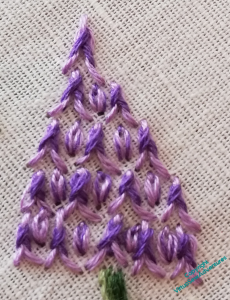
All that admitted, I felt I’d ended up with too great a space between the stitches, and of course, I don’t want to try to fit more in, in case I lose the ruffles (as it were!). So I have filled in the gaps with single detached chain stitches.
Of course, I may yet come back and do somethign entirely different. but I decided at this point to leave this in place and continue my experiments!
The next SlowTV Stitchery is now live. Episode 36 tackles the difficulties of the canvas, Reynard the Fox provides a distraction, and there is some tackling of quandaries by changing tack..
Still more progress on the tablecloth
It’s arguable that I’ve created a sampler rather than a tablecloth, but as I’ve got closer to finishing it and laid it on the floor to look for any missing bits, it’s looking cheerful, and that is really all I ask of it.
Mountmellick Thorn Stitch is an old friend, strongly textured but contained. It’s not entirely straightforward to shape it to the leaf shape of the design, but I think it works rather well!
Nested Fly Stitch is another old friend, although one I’m not on such good terms with as some others. In the dim and distant past I worked two 2-foot high trees in Nested Fly Stitch (on the Persian Fantasy Screen) and they drove me nearly demented! However, it does create a solid coverage that isn’t fishbone stitch or satin stitch, and I wanted to make sure that the various leaves varied in coverage and tone. This is the “Heavy” end of the scale!
And this is the “Light” end of the scale – just outlines, in stem or chain stitch. These flow beautifully around curves, of course, and are really good for organic shapes, but I do need to remind myself that I don’t have to use obscure stitches all the time, and I’m allowed to choose the obvious ones occasionally!
The next episode – Episode Seventeen – of SlowTVStitchery is now up, and concerns mainly the little girls and some planning of Nefertiti..
More progress on the tablecloth
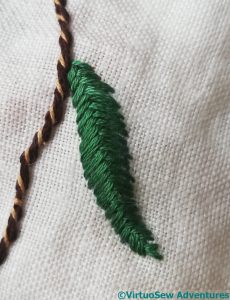
Each time I decide how to do a particular element, I do all four appearances. I decided on this very early on, because I knew that working a whole side and then copying it three times would drive me absolutely mad!
Raised fishbone stitch creates a nicely embossed effect, providing a good contrast with all the open stitches I’ve used. It requires a bit of concentration – this is a little raggier than I’d like – but at this point, I want the wretched tablecloth done, so I’m likely to just move on..
I’ve been looking at other embroidery styles of late – one can’t be wallowing in gold all the time, and one of these days I will be able to think of doing something else – and I’ve been reminded of just how effective groupings of blanket stitch or buttonhole stitch can be. This is the simplest variant I could think of, but I must remember that simple stitches like blanket stitch offer endless possibilities for variation..
One of the attractions of surface embroidery is the possibility for stitches to evolve themselves into being. I’m calling this one “Feathered Zig Zag Chain Stitch”. I can’t believe I’ve invented it, but neither can I remember having seen it before, and I think it works rather well. It certainly flowed familiarly off the needle, like an old friend.
The photograph has reminded me, however, that I need to finish whipping my chain stitch stems!
And new in SlowTVStitchery, Episode Thirteen is now up. In which, at long last, a Decision is made….
Progress on a project long in abeyance
You may recall this tablecloth, which I won in a job lot of things in an auction on eBay, a long time ago. I regarded it as my “traveling project” for a while, but didn’t travel much, or when I got there, found I couldn’t settle to it, and it’s been lingering and hanging over my head rather. It may well be that the current situation will give me the opportunity to get it finished. It will make a change from the details of the Amarna Family Group!
So, since I’d forgotten what I’d planned (or if I’d planned!), I laid it out on the floor and played around with skeins of cotton, to see what I could come up with.
The way I’ve worked on the tablecloth is that as I’ve what to do with each motif, I’ve worked each instance, and that way the whole tablecloth advances at once.
The Basque Stitch of these leaves is rather more spaced out than in the previous appearance of that stitch in the tablecloth – spacing, as well as scale, plays a part in altering the appearance and emphasis of a stitch.
Coral Stitch is nice and simple. Such a nice rest…
Yes, I know the concept of or nué is simple, but the execution isn’t, believe me!
And, speaking of or nué, Episode 12 of SlowTVStitchery is up! Do go and have a quiet half hour with me…
A backing for the Robin (in progress!)
You may vaguely recall the little robin with stumpwork holly that I worked a couple of years ago. I mounted him on a circle of card and then didn’t make any more progress..
But I have now!
I’m using leftover fragments of silk from various Thistle Threads courses to do a rather tame crazy patchwork circle to cover the padding for the back, and then he can hang or be propped in a corner somewhere, looking cheery. I’ve settled on a simple quadrant arrangement, so I have four seams to deal with.
I said, when I found “Floral Feather Stitch” that I’d be using it again, and here it is, tweaked and embellished with a Fly stitch and a French Knot to emphasize the “floral” element. I really like this stitch – a simple, but extremely effective variation. Or maybe a stitcher’s “mash-up”!
The second uses Interlaced Herringbone Stitch, with the second pass interwoven with the first and then tied down with short straight stitches. This one is maybe a little monolithic, but the first one is so simple, I didn’t want to unbalance the appearance with anything broader.
The third is Chevron Stitch, embellished with alternating Fly Stitches and Detached Chain Stitches on the “top” edge. This one went a little ragged, but I still think it works.
The final one has alternating Half Buttonhole Wheels with Straight Stitches filling the gaps. Again, this could have been expanded and extended, but I thought there was quite enough for the purpose!
Nefertiti Shawl – partial panels
There are partial red panels at the edges of the Shawl, and as I want the colours to run the whole way across, clearly I have to stitch them. While I was mulling over the blue panels and the green ones, I carried on with those partial panels.
The central circles in all cases are in chain stitch and stem stitch, but I wanted a variety of effects in the main circles. That wasn’t as easy to achieve as you might think, for all my extensive repertoire of stitches! I found “German Knotted Blanket Stitch” in Barbara Snook’s “Embroidery Stitches”, and Palestrina and Loop Stitch are old friends, but by this point I’d managed to rack my brain into remembering most of those..
I was beginning to be at my wits end for stitches, and spent some time rummaging in Edith John’s “Creative Stitches” and “New Stitches for Embroidery”. Many of them would be easier in a slightly stiffer thread at a slightly larger scale, so I find myself wondering what Miss John devised her stitches for.
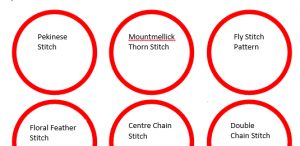
The full circles here are in stitches which are old friends, but the partial circles are some of hers. Floral Feather is a feather stitch with an upside down blanket stitch beside it, and I quite fell in love with it. I’ll be looking for another opportunity to use that one!.
Centre Chain stitch alternates single chain with fly stitch, starting each chain stitch within the previous one. That might be a way to vary textures with Wheatear Stitch, while still keeping the overall pattern. And Double Chain Stitch places a chain stitch and an open chain stitch side by side, alternating the ordering to create a checked effect.
Same design, different stitches
I’ve been rummaging in a variety of boxes, because with “Leaving the Tyne, 1915” finished and on display, and two “Dreams of Amarna” pieces in a good state, I feel as though I have a bit of mental space and time to consider, not just the progress on the Dreams of Amarna, but also any other half-thought-through bits and pieces I may find.
I’m not sure whether that is going to be true, but I live in hope! These “bits and pieces” are particularly obscure and particularly hard to find something to do with.
These two Lovely Ladies were part of an exploration of stitch ideas and silhouettes, originally with the idea that they might become teaching pieces. They originate with a sampler of cross stitch and ribbonwork silhouettes I devised in “DevaStitch Designs” days.
When I thought of teaching, I extended the idea by enlarging the heads, and playing with stitchery to replace the ribbonwork. However, I’m not much of a teacher at the best of times, and when I asked a few people, I was told that the second version, with silk georgette layered to create the impression of the silhouette, would be daunting for beginners, and uninteresting for improvers.
Ouch.
So I’m still trying to work out what to do with them. I rather enjoyed doing the silk georgette (it’s held down with back stitch, then chain stitch, and then satin stitched over the top!), and it certainly makes the bead necklace stand out nicely. The two parts of the hat provide clear, distinct shapes to outline and fill with stitched patterns.
I still have some ideas for a lady in the cloche hat that I’m dying to put into action, but at the moment I have no good excuse to do so!

